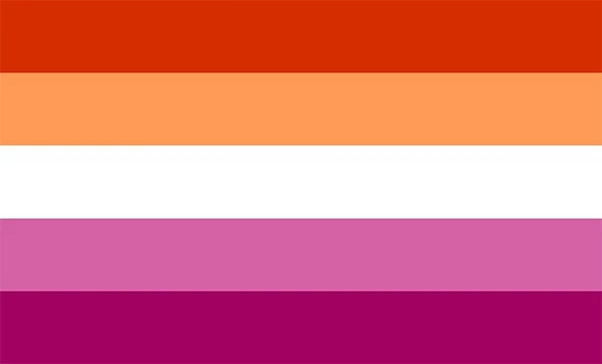Lesbian Flag

Lesbian and gay rights have been a contentious issue for many years. There are many different opinions on the topic, and as a result, there is no unified symbol or flag that represents all lesbians and gay people. There are several lesbian and gay rights flags that have been proposed over the years, but none of them has gained widespread support. The most commonly known flag is the pink triangle, which was used to identify homosexuals during the Nazi regime.
Lesbian, gay, bisexual and transgender (LGBT) communities around the world have adopted various flags to show solidarity and representation. The rainbow flag, often associated with the LGBT movement, is one of the most well-known symbols of pride. However, not all LGBT communities have a flag that represents them. In countries where homosexuality is still considered illegal or taboo, there are few official symbols or flags to represent the LGBT community.
Lesbian, gay, bisexual and transgender (LGBT) people have long been fighting for equal rights and acceptance. Recently, they have also been rallying around the rainbow flag, which symbolizes their commitment to diversity. The flag has become a symbol of pride for LGBT people all over the world.
Lesbian Flag Colors
The rainbow flag has been adopted as the symbol of the LGBTQ+ community, and it is now considered a global symbol of diversity. However, not all LGBTQ+ people identify with the traditional colors of the flag. Some lesbian, gay, bisexual, transgender, and queer (LGBTQ+) people prefer to use different colors to represent themselves and their community.
Lesbian, gay, bisexual and transgender rights are becoming increasingly important issues on the political landscape. Supporters of these rights often display rainbow flags with the colors representing their orientation. Here is a look at the colors of the lesbian flag:
The red stripe represents love and passion.
The orange stripe represents strength and courage.
The yellow stripe represents sunshine and happiness.
The green stripe represents nature and growth.
And the blue stripe represents peace and harmony.
Lesbian, gay, bisexual and transgender (LGBT) flag colors have been a topic of debate for years. Some people argue that the rainbow flag with its seven colors represents all people and should be flown universally, regardless of orientation. Others feel that specific LGBT colors should be used to represent their community.
Lipstick Lesbian Flag
Lesbian lipstick is one of the most iconic symbols of the LGBT community. Lesbian lipstick has been used as a way to identify and support one another for centuries. In recent years, lesbian lipstick has become an unofficial symbol of the LGBT community. Lesbians have adopted the color pink as their signature color, and many businesses have created products in honor of the LGBT community. The lesbian lipstick flag was created in 2007 by artist Tracey Seawright.
Lesbian and bisexual women have long been marginalized in society, but they are beginning to gain visibility with the creation of the lesbian lipstick flag. The flag features a pink triangle on a white background, signifying that lesbians have suffered from oppression and discrimination just like other minorities. The flag is designed to help lesbians and bisexual women raise awareness and fight for their rights.
Lesbianism has long been an accepted part of the queer community. However, until recently, there hasn’t been a specific flag or symbol to represent this group. That all changed on May 17th, when the lipstick lesbian flag was officially adopted as the official symbol of the International Lesbian, Gay, Bisexual, Trans and Intersex Association (ILGA).
The flag consists of a pink triangle with a red stripe running through it.
Sunset Lesbian Flag
The flag of the lesbian, gay, bisexual, transgender (LGBT) community is often associated with pride and celebration. The colors blue, pink, and white are traditionally associated with the LGBT community. The flag was designed in 1986 by Lisa Jardina, an artist and activist in the LGBT community. Jardina wanted to create a flag that represented diversity and unity among the LGBT community.
The lesbian, gay, bisexual and transgender (LGBT) community has been fighting for equal rights and acceptance for years. One way to show support is to fly a rainbow flag at sunset.
In 2007, the Flagstaff City Council in Arizona approved a proposal to fly a LGBT pride flag at half-staff on City Hall every day from Memorial Day through Labor Day. The ordinance received criticism from some residents who believed that it was a display of political correctness.
Lesbian, gay, bisexual and transgender (LGBT) pride flags have been flown at various events in cities around the world as a sign of support for the LGBT community. On Sunday, June 24, 2016, the first LGBT flag was raised atop the San Francisco City Hall during a sunset ceremony. The flag was created by artist Michael Graham and features a pink triangle on a yellow background.
New Lesbian Flag
Lesbian pride flags are a part of the LGBT community’s history and culture. They have been flown at protests and pride events around the world to show support for lesbian, gay, bisexual, transgender, and queer people. Recently, there has been a new flag designed specifically for lesbians. The flag features a purple stripe in the middle with two pink stripes on either side. The stripes represent the female and male genders, respectively.
In early 2016, the Flag Institute, a nonpartisan research organization dedicated to the study of flags and flag symbolism, released a report proposing that a new lesbian flag be created. The rainbow flag, which had originally been designed as an international symbol of gay rights, now also represents the diversity of the LGBTQ+ community. Outrage over Russia’s 2014 law criminalizing “gay propaganda” prompted the proposal for a new lesbian flag.
Lesbian, gay, bisexual and transgender people (LGBT) have been fighting for equal rights for decades. Recently, they have been working towards creating their own flags to represent their communities. The new flag was created in response to exclusion of LGBT people from the global flag design contest.
The flag consists of a pink triangle on a light blue background. The triangle is symbolic of the persecution of LGBT people throughout history.




